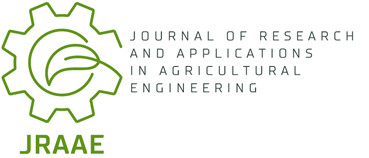Current issue
Online First
Archive
Instructions for Authors
Guide for Authors
Peer Review Policy
Research Ethics Policy
Ghostwriting and Guest Authorship
Copyright
Open Access Policy
Plagiarism
About the Journal
Aim and Scope
Scientific Board
Publisher
Editorial Board
Indexing in Databases
Personal Data Protection
Repository Policy
Contact
ORIGINAL PAPER
The influence of pasteurization process and storing on bioaciwe compound content in pickled red pepper fruits from organic and conventional production
Journal of Research and Applications in Agricultural Engineering 2009;54(3):90-94
KEYWORDS
ABSTRACT
Organic agriculture is a system of crop production without mineral fertilizers and synthetic pesticides. Natural fertilizers as manure, compost also green manure are widely used. For plant protection the natural insect predators and plants extracts are used. A lot of research made in Europe and Poland confirmed that crops from organic agriculture contained more bioactive compounds as flavonoids, carotenoids also vitamin C. The sweet red pepper is a good source of vitamin C, flawnoids especially rutin also carotenoids: capsorubin, capsantin, beta-carotene and lutein. Processing of fruits and vegetables is a good method to enhance diversity of diet. However, processing also decreases a level of bioactive compounds in comparison to the raw material. Therefore it was important to conduct the presented experiment. In the experiment two cultivars of sweet red pepper (Roberta and Berceo) from organiv and conventional cultivation were used. Fruits of all cultivars were picked up in this same maturity time and processed. After the pickling process fruits were divided into three groups: fresh (after pickling), pasteurized and pasteurized and stored 6 month. Fruit samples of each group were freeze-dried and chemically analyzed. The content of dry matter, witamin C, flavonoles, fenolic acids and carotenoids were carried out. The results obtained showed that pickled red pepper from organic production contained more vitamin C, flavonoles, fenolic acids, carotenoids and dry matter than the products from conventional production. After pickling process the organic samples were still richer in vitamin C, flavonoles, fenolic acids, lutein and dry matter than conventional ones. After storage period the content of bioactive compounds in the products has decreased; a decline was stronger in the organic samples than in the conventional ones.
REFERENCES (17)
1.
Asami D. K., Hong Y. J., Barrett D. M, Mithel A. E.: Comparison of the phenolic and ascorbic acid content of freeze – dried and air - dried marionberty, strawberry, and com grown using conventional, organic and sustainable agricultural practices. J. Agric. Food Chem., 2003, 51, 1237-1247.
2.
del Amor F.M., Serrano-Martinez A., Fortea M.A., Nunez-Delicado E: Differential effect of organic cultivation on the levels of phenolies, peroxidase and capsidiol in sweet peppers. J. Sci Food Agric., 2008, 88, 770-777.
3.
Brandt K., Melgaard J.P.: Organic agriculture: does it enhance or reduce the nutritional value of plant foods? J. Sci. Food Agric, 2001, 81, 924-931.
4.
Chassy A.W., Bui L., Renaud E.N.C., van Horn M, Mitchell A.E.: Three year comparison of the content of antioxidant micro-constituents and several quality characteristies in organic and conventionally managed tomatoes and bell peppes. J. Agric. Food Chera, 2006, 54, 8244-8252.
5.
Deepa N., Kaur Ch., George B., Singh B., Kapoor H.C.: Anti-oxidant constituents in some sweet pepper {Capsicum annuum L.) genotypes during maturity. LWT, 2007, 40, 121-129.
6.
Garcia M.I., Lozano M., de Espinosa V.M., Ayusto M. C, Bernalte M.J., Vidal-Aragon M.C., Perez M.M. Agronomic characteristies and carotenoid content of five Bola-type red pepper {Capsicum annuum L.) cultivars. Sci. Hort., 2007, 113, 202-207.
7.
Hallmann E., Rembiałkowska E.: Zawartość związków bioaktywnych w owocach papryki z uprawy ekologicznej i konwencjonalnej. Żyw. Człow. i Met. XXXIV 2007, nr 1/2, 538-543.
8.
Mann A., Ferreres F., Tomaas-Barberaan F.A., Gil M.I.: Characterization and quantitation of antioxidant constituents of sweet pepper {Capsicum annuum L.). J. Agric. Food Chera, 2004, 52, 3861-3869.
9.
Perez-López A J., del Amor F.M., Serrano-Martinez A., Forteal M.A., Nunez-Delicado E.: Influence of agricultural practices on the quality of sweet pepper fruits as affected by the maturity stage. J. Sci. Food Agric, 2007, 87, 2075-2080.
10.
Polska Norma, PN-A-75101-03:1990, Analiza chemiczno-rolnicza roślin. Oznaczanie powietrznie suchej i suchej masy.
11.
Polska Norma, PN-A-75101-11:1990, Przetwory owocowe i warzywne. Przygotowanie próbek i metody badań fizykochemicznych. Oznaczanie zawartości witaminy C.
12.
Rembiałkowska E., Hallmann E., Szafirowska A.: Nutritive quality of tomato fruit from organic and conventional cultivation: Culinary Arts, SGGW, 2005, 193-202.
13.
Rembiałkowska E., Hallmann E.: Zmiany zawartości związków bioaktywnych w owocach papryki marynowanej z uprawy ekologicznej i konwencjonalnej. Journal of Research and Applications in Agricultural Engineering, 2008, Vol. 53(4), 51-57.
14.
Rembiałkowska E., Hallmann, Wasiak-Zys G.: Jakość odżywcza i sensoryczna pomidorów z uprawy ekologicznej i konwencjonalnej. Żyw. Człow. Met. XXX, 2003, nr 3/4, 203-209.
15.
Saniawski M., Czapski J.: The effect of methyl jasmonate on lycopene and b-carotene accumulation in ripening red tomatoes. Exper. 1983, 39, 1373-1374.
16.
Strzelecka H., Kamińska J., Kowalski J., Wawelska E.: Chemiczne metody badań roślinnych surowców leczniczych. Warszawa: PZWL, 1978.
17.
Young J.E., Zhao X., Carey E.E., Welti R., Yang Sh-Sh., Wang W.: Phytochemical phenolies in organically grown vegetables. Mol. Nutr. Food Res., 2005, 49, 1136-1142.
Share
RELATED ARTICLE
We process personal data collected when visiting the website. The function of obtaining information about users and their behavior is carried out by voluntarily entered information in forms and saving cookies in end devices. Data, including cookies, are used to provide services, improve the user experience and to analyze the traffic in accordance with the Privacy policy. Data are also collected and processed by Google Analytics tool (more).
You can change cookies settings in your browser. Restricted use of cookies in the browser configuration may affect some functionalities of the website.
You can change cookies settings in your browser. Restricted use of cookies in the browser configuration may affect some functionalities of the website.


